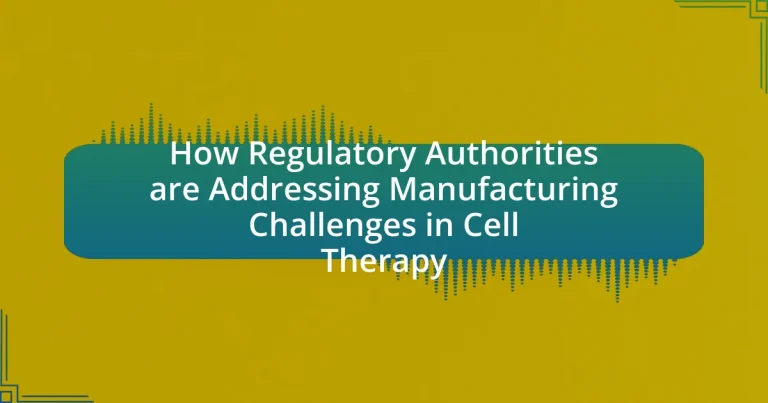The article focuses on the manufacturing challenges faced in cell therapy, particularly emphasizing scalability, consistency, and regulatory compliance. It outlines how these challenges impact the development and commercialization of cell therapies, leading to increased costs and extended timelines for clinical trials. The article also discusses specific manufacturing processes affected by these challenges, such as cell expansion and quality control, and highlights the role of regulatory authorities like the FDA and EMA in establishing guidelines to ensure safety and efficacy. Additionally, it examines current initiatives aimed at supporting manufacturers and the future trends in regulatory approaches that may influence cell therapy manufacturing practices.

What are the key manufacturing challenges in cell therapy?
The key manufacturing challenges in cell therapy include scalability, consistency, and regulatory compliance. Scalability is a significant issue as producing sufficient quantities of cells for therapeutic use often requires complex and costly processes. Consistency in cell quality and functionality is crucial, as variations can lead to ineffective treatments or adverse effects. Regulatory compliance poses additional challenges, as manufacturers must navigate stringent guidelines to ensure safety and efficacy, which can complicate the development and approval processes. These challenges are critical for the successful commercialization of cell therapies, as highlighted by the increasing focus of regulatory authorities on establishing clear frameworks to address these issues.
How do these challenges impact the development of cell therapies?
Challenges in manufacturing cell therapies significantly delay their development and commercialization. These challenges include complex manufacturing processes, stringent regulatory requirements, and variability in product quality, which can lead to increased costs and longer timelines for clinical trials. For instance, the U.S. Food and Drug Administration (FDA) has emphasized the need for robust quality control measures, which can complicate the manufacturing process and extend the time required to meet regulatory standards. Consequently, these factors can hinder innovation and limit patient access to potentially life-saving therapies.
What specific manufacturing processes are most affected by these challenges?
The specific manufacturing processes most affected by challenges in cell therapy include cell expansion, quality control, and product characterization. These processes are critical as they directly impact the efficacy and safety of cell therapies. For instance, cell expansion requires stringent monitoring to ensure consistent cell growth and viability, which can be hindered by regulatory compliance issues. Quality control processes are also affected, as they must adhere to rigorous standards set by regulatory authorities, leading to potential delays in production. Additionally, product characterization is challenged by the need for precise identification and quantification of cell types, which is essential for meeting regulatory requirements. These challenges highlight the complexities faced by manufacturers in the cell therapy sector, necessitating robust regulatory frameworks to ensure compliance and product integrity.
How do regulatory requirements complicate these manufacturing processes?
Regulatory requirements complicate manufacturing processes in cell therapy by imposing stringent standards for safety, efficacy, and quality control. These regulations necessitate extensive documentation, validation, and testing, which can prolong development timelines and increase costs. For instance, the FDA mandates that cell therapy products undergo rigorous clinical trials to demonstrate their safety and effectiveness before approval, often requiring multiple phases of testing that can take years to complete. Additionally, compliance with Good Manufacturing Practices (GMP) requires facilities to maintain specific environmental conditions and operational protocols, further complicating production logistics and scalability.
Why is it important for regulatory authorities to address these challenges?
It is important for regulatory authorities to address manufacturing challenges in cell therapy to ensure patient safety and product efficacy. Regulatory oversight helps establish standards that guarantee the quality of cell therapies, which are complex and sensitive to variations in manufacturing processes. For instance, the FDA has implemented guidelines that require rigorous testing and validation of cell therapy products to prevent adverse effects and ensure consistent therapeutic outcomes. Addressing these challenges also fosters innovation by providing a clear regulatory pathway, which encourages investment and development in the field of cell therapy.
What role do regulatory authorities play in ensuring safety and efficacy?
Regulatory authorities play a critical role in ensuring the safety and efficacy of cell therapies by establishing and enforcing standards for product development, manufacturing, and clinical testing. These authorities, such as the U.S. Food and Drug Administration (FDA) and the European Medicines Agency (EMA), evaluate clinical trial data to confirm that therapies meet safety benchmarks and demonstrate effectiveness before they can be marketed. For instance, the FDA requires comprehensive preclinical and clinical data to assess the risk-benefit profile of cell therapies, ensuring that only those with proven safety and efficacy reach patients. This rigorous oversight helps prevent unsafe or ineffective treatments from entering the market, thereby protecting public health.
How can addressing manufacturing challenges improve patient outcomes?
Addressing manufacturing challenges in cell therapy can significantly improve patient outcomes by ensuring the consistent quality and efficacy of therapeutic products. When manufacturing processes are optimized, the risk of product variability decreases, leading to more reliable treatment results for patients. For instance, a study published in the journal “Nature Biotechnology” highlighted that standardized manufacturing protocols can enhance the potency and safety of cell therapies, ultimately resulting in better clinical responses and reduced adverse effects. By focusing on these challenges, regulatory authorities can facilitate the development of robust manufacturing practices that directly correlate with improved patient health outcomes.

How are regulatory authorities currently addressing manufacturing challenges in cell therapy?
Regulatory authorities are currently addressing manufacturing challenges in cell therapy by implementing streamlined guidelines and frameworks that enhance the efficiency and safety of production processes. For instance, the U.S. Food and Drug Administration (FDA) has introduced the “Regenerative Medicine Advanced Therapy” (RMAT) designation, which expedites the development and review of cell therapies, thereby facilitating quicker access to the market while ensuring compliance with safety standards. Additionally, the European Medicines Agency (EMA) has established the “Advanced Therapy Medicinal Products” (ATMP) regulation, which provides a clear pathway for the approval of innovative therapies, addressing manufacturing complexities by requiring robust quality control measures and risk management strategies. These initiatives reflect a commitment to balancing innovation with patient safety, as evidenced by the increasing number of approved cell therapies in recent years, demonstrating the effectiveness of these regulatory approaches.
What guidelines have been established by regulatory authorities?
Regulatory authorities have established guidelines focused on ensuring the safety, efficacy, and quality of cell therapies. The U.S. Food and Drug Administration (FDA) has issued specific guidance documents, such as the “Guidance for Industry: Considerations for the Design of Early-Phase Clinical Trials of Cellular and Gene Therapy Products,” which outlines critical aspects of trial design, manufacturing processes, and product characterization. Additionally, the European Medicines Agency (EMA) has developed the “Guideline on the quality, non-clinical and clinical aspects of gene therapy medicinal products,” emphasizing the need for comprehensive quality control and risk assessment throughout the manufacturing process. These guidelines are essential for standardizing practices and ensuring that cell therapies meet regulatory requirements before reaching patients.
How do these guidelines influence manufacturing practices?
These guidelines significantly influence manufacturing practices by establishing standardized protocols that ensure product safety, efficacy, and quality in cell therapy. Regulatory authorities, such as the FDA and EMA, mandate compliance with Good Manufacturing Practices (GMP), which require rigorous testing, documentation, and quality control measures. For instance, adherence to these guidelines has led to improved consistency in cell product manufacturing, as evidenced by the increased approval rates of cell therapies, which rose from 2% in the early 2000s to over 50% in recent years. This shift underscores the critical role that regulatory frameworks play in shaping manufacturing processes to meet stringent safety and quality benchmarks.
What are the key components of these guidelines?
The key components of the guidelines addressing manufacturing challenges in cell therapy include quality control measures, risk management protocols, and compliance with Good Manufacturing Practices (GMP). Quality control measures ensure that cell therapy products meet safety and efficacy standards, while risk management protocols identify and mitigate potential manufacturing risks. Compliance with GMP is essential for maintaining product integrity and ensuring that manufacturing processes adhere to regulatory requirements. These components are critical for ensuring the safety and effectiveness of cell therapies in clinical applications.
What initiatives are being implemented to support manufacturers?
Regulatory authorities are implementing initiatives such as streamlined approval processes, guidance documents, and funding programs to support manufacturers in the cell therapy sector. For instance, the FDA has introduced the Regenerative Medicine Advanced Therapy (RMAT) designation, which expedites the development and review of cell therapies, thereby reducing time to market. Additionally, the European Medicines Agency (EMA) provides scientific advice and regulatory support to help manufacturers navigate complex regulations. These initiatives aim to enhance innovation, ensure product safety, and facilitate access to advanced therapies for patients.
How do these initiatives facilitate compliance with regulations?
These initiatives facilitate compliance with regulations by establishing standardized protocols and guidelines that align with regulatory requirements. For instance, regulatory authorities often implement frameworks that require manufacturers to adhere to Good Manufacturing Practices (GMP), ensuring product quality and safety. Additionally, initiatives such as regular audits and inspections help verify compliance, while training programs for staff ensure that all personnel are knowledgeable about regulatory standards. This structured approach not only minimizes the risk of non-compliance but also fosters a culture of accountability within organizations, ultimately leading to safer and more effective cell therapy products.
What resources are available for manufacturers facing challenges?
Manufacturers facing challenges in cell therapy can access various resources, including regulatory guidance documents, industry associations, and funding opportunities. Regulatory authorities like the FDA provide comprehensive guidelines that help manufacturers navigate compliance and quality assurance processes. Industry associations, such as the Alliance for Regenerative Medicine, offer networking opportunities, educational resources, and advocacy support. Additionally, funding programs from government agencies and private investors can assist manufacturers in overcoming financial barriers, as evidenced by initiatives like the National Institutes of Health’s funding for regenerative medicine research. These resources collectively support manufacturers in addressing operational and regulatory challenges effectively.

What future trends can be expected in regulatory approaches to cell therapy manufacturing?
Future trends in regulatory approaches to cell therapy manufacturing will likely include increased harmonization of regulations across jurisdictions, enhanced focus on patient safety, and the integration of advanced technologies such as artificial intelligence in manufacturing processes. Regulatory bodies, such as the FDA and EMA, are moving towards a more unified framework to streamline approvals and ensure consistent quality standards globally. This trend is supported by initiatives like the International Council for Harmonisation (ICH), which aims to align regulatory requirements. Additionally, as cell therapies become more complex, regulators are emphasizing robust risk management strategies and real-time monitoring to safeguard patient outcomes, reflecting a shift towards proactive regulatory practices.
How might evolving technologies influence regulatory practices?
Evolving technologies significantly influence regulatory practices by necessitating adaptive frameworks that can accommodate rapid advancements in areas such as cell therapy manufacturing. For instance, the integration of artificial intelligence and machine learning in quality control processes allows for real-time monitoring and predictive analytics, which can enhance compliance and safety standards. Regulatory bodies, such as the FDA, have begun to implement guidelines that reflect these technological advancements, as seen in the FDA’s 2020 guidance on the use of digital health technologies in clinical trials. This shift towards embracing innovative technologies ensures that regulatory practices remain relevant and effective in overseeing complex manufacturing processes in cell therapy.
What role will innovation play in shaping future regulations?
Innovation will play a crucial role in shaping future regulations by enabling regulatory authorities to adapt to rapid advancements in cell therapy technologies. As new manufacturing techniques and therapies emerge, regulatory frameworks must evolve to ensure safety and efficacy while fostering innovation. For instance, the introduction of advanced manufacturing processes, such as automated cell processing and gene editing technologies, necessitates updated guidelines to address unique challenges and risks associated with these innovations. Historical examples, such as the FDA’s expedited pathways for breakthrough therapies, demonstrate how regulatory bodies can leverage innovation to streamline approval processes while maintaining rigorous safety standards.
How can manufacturers prepare for upcoming regulatory changes?
Manufacturers can prepare for upcoming regulatory changes by conducting thorough assessments of current compliance practices and aligning them with anticipated regulations. This proactive approach involves staying informed about regulatory updates from authorities such as the FDA and EMA, which have been increasingly focused on cell therapy standards. For instance, the FDA’s guidance on the development of cell-based therapies emphasizes the need for robust quality systems and risk management strategies. By implementing these practices, manufacturers can ensure they meet evolving requirements and mitigate potential compliance risks.
What best practices should manufacturers adopt to align with regulatory expectations?
Manufacturers should adopt a comprehensive quality management system to align with regulatory expectations. This system should include rigorous documentation practices, regular audits, and adherence to Good Manufacturing Practices (GMP) to ensure product safety and efficacy. For instance, the FDA mandates that cell therapy manufacturers comply with specific guidelines outlined in 21 CFR Part 1271, which emphasizes the importance of quality control and risk management. By implementing these practices, manufacturers can demonstrate compliance and enhance their operational efficiency, ultimately leading to improved patient outcomes.
How can manufacturers ensure quality control in their processes?
Manufacturers can ensure quality control in their processes by implementing standardized operating procedures (SOPs) and conducting regular audits. SOPs provide clear guidelines for each step of the manufacturing process, ensuring consistency and compliance with regulatory standards. Regular audits, both internal and external, help identify deviations from these procedures and facilitate corrective actions. According to the FDA, adherence to Good Manufacturing Practices (GMP) is essential for maintaining product quality and safety, which underscores the importance of these practices in the cell therapy manufacturing sector.
What strategies can be employed to stay updated on regulatory changes?
To stay updated on regulatory changes, professionals should utilize a combination of monitoring regulatory agency websites, subscribing to industry newsletters, and participating in relevant professional associations. Regulatory agencies such as the FDA and EMA regularly publish updates and guidelines on their websites, which serve as primary sources of information. Industry newsletters, like those from BioPharma Dive or Regulatory Affairs Professionals Society, provide curated news and insights on regulatory developments. Additionally, joining professional associations, such as the International Society for Cell & Gene Therapy, offers access to resources, webinars, and networking opportunities that keep members informed about the latest regulatory trends and challenges in cell therapy manufacturing.




